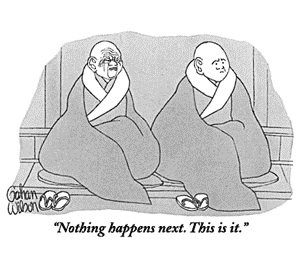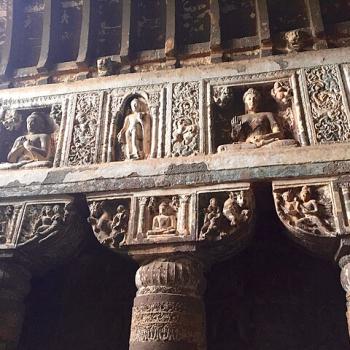THE ONE, THE MANY AND THE GREAT EMPTY
Zen, Koans, Awakening & the Course of our Lives
Some Notes
James Ishmael Ford
I was talking with a friend about spiritual direction in Zen Buddhism, particularly among those of us who walk the way of koan introspection. Somehow the subject turned toward initial awakening experiences, enlightenment experiences, sometimes called kensho in Japanese and jian xing in Chinese, standing for the realization of our fundamental nonduality.
I asserted my view that pretty much everyone has had an awakening experience somewhere along the line in their lives, often in youth or even in childhood. This makes sense on the face of it as the assertion within the great way is we are swimming within awakening, we are breathing awakening, in and out, there is no part of us that isn’t part and parcel of awakening. Only our ignorance of this reality keeps us from noticing who and what we actually are.
And, so, in practice interviews I often ask people whether they’ve had some kind of moment in their lives where everything clicks into place. I said how I say the language for this is various, but often people say they felt at one with everything.
My friend observed how this “oneness” experience isn’t awakening, at least not within Zen. Rather awakening is the moment where we see all things are empty, lack essentialness, are open, are boundless. In fact even saying “experience” sullies the moment, misdirects what is discovered. Not to mention “oneness.”
Of course he’s right.
Nondual. Not one. Not two. (And for that person who completely misses this, not three…)
But.
But, what about that sense of “one?” It is quite a bit more common. And, indeed, it is, as I said, the experience so many people can report. Where does it fit into the scheme of things on our Zen way? And, should I not encourage people by lightly suggesting that moment of oneness is kensho?
In fact the matter of usage isn’t cut and dry. Victor Sogen Hori, long time Zen practitioner and scholar observes in his essay “Teaching and Learning in the Rinzai Zen Monastery,” that translating the word as it usually is, as “seeing into one’s nature” is misleading. He says how “In Japanese kensho is used to cover anything from a slight insight to a total spiritual transformation of character and personality…”
So there, I say to my friend.
But.
But even when kensho is understood as the dropping away of self and other, the matter does not end. The unsigned Wikipedia article on “kensho” reports the Chan master Sheng Yen’s comment the “Ch’an expressions refer to enlightenment as ‘seeing your self-nature.’ But even this is not enough. After seeing yourself-nature, you need to deepen your experience even further and bring it into maturation. You should have enlightenment experiences again and again and support them with continuous practice. Even though Ch’an says at the time of enlightenment, your outlook is the same as of the Buddha, you are not yet a full Buddha.” This is my understanding, as well. In fact in Zen there’s an old saying how “even the Buddha is still practicing.”
So, we need to avoid the trap of asserting a moment where everything is changed forever more and we can put a period, or maybe even an exclamation mark to it all.
Always training.
Still, my concern here is with the more preliminary insights, those little tastes that inform and direct us on. And how best to acknowledge and use them.
I think there tend to be two ways to help people on the path. One is to hold. The other is to “pull the string.” Each has shadows. Holding, just being there, but when the presentation isn’t on the mark, saying no. Lots of saying no. Lots and lots of saying no. The downside is it can break the heart, and not in the good way, and people who really wish for the deeper way, still, lose hope, and give up. I’ve seen a fair amount of this.
But pulling the string, noticing the smallest movement in the “right” direction, and encouraging has its downsides, as well. Here the smallest of intimations can be taken as much more than they are. Only recently I’ve had someone who I encouraged for expressing the limitation of his words to be an actual insight. And correcting that has been difficult. I’d said yes. Wasn’t that a real yes?
The way is one continuous mistake.
Of course.
So, all this said, what about that experience of oneness?
It is totally authentic.
It speaks to a profound understanding that we do not end at our skins, that our lives and the lives of everyone else, indeed, our existence and the existence of everything else are intertwined so deeply, so intimately that word “one” makes a lot of sense.
And, it isn’t the dropping away of self and other.
And, it does appear sometimes on our Zen way people confuse the two. So, we need to be careful.
The path is too important to play fast and loose.
But, even as many teachers suggest Samadhi experiences, those moments of deep quiet, near total quiet, oneness with the moment are the field of awakening, just so our intimations of unity are a step on this path that has no stages, a moment that shatters conceptions of previous moments.
Yes, it sets up a story that can be very seductive.
But, with real friends, a continuous practice, and constant checking, well, the next step that really isn’t a step presents soon enough.
And we find we can slither our way up that hundred foot pole, and discover what is up there near the top.
And, then, then, take the next step, a step that really isn’t there, away…
Open.
Vast.
Boundless.
In this body of fluids and matter and storms and calms.













